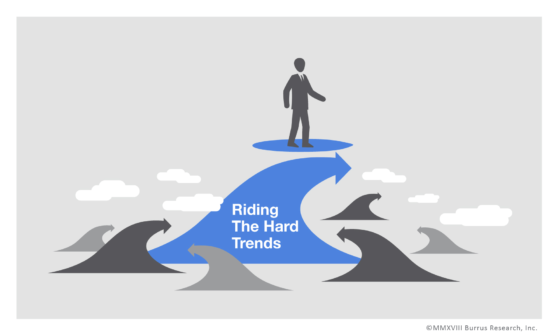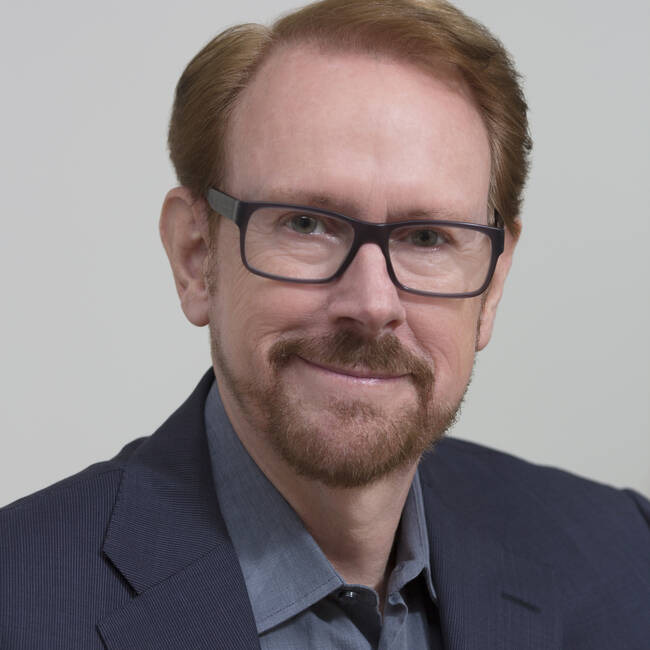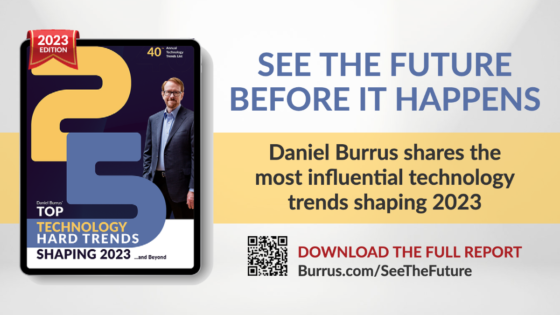Seven Principles for being Anticipatory

Have you ever wished you could predict the future--and be right? What would it be like if you could clearly see critical changes in the months and years ahead, and use those glimpses to shape that future instead of just letting it unfold by default?

You can accurately predict enough of the future to make all the difference. In fact, you can hone your ability to trigger a burst of accurate insight about the future and use it to produce a new and radically different way of doing things. Being anticipatory is about looking into the future and transforming it into a new paradigm for solving "impossible" problems, unearthing "invisible" opportunities, and positioning yourself as a leader in your organization and industry.
I have discovered seven principles or "triggers" that accelerate innovation and growth. They are:
#1 Start with Certainty (use Hard Trends to see what's coming)
You can use the power of certainty to spot and profit from future trends long before your competitors do. Just look at Apple, who accurately saw the trends of accelerating bandwidth, processing power, and high-capacity storage and harnessed them to create the mega hits iPod, iTunes, iPhone, and iPad. Meanwhile, Polaroid, Kodak, and Motorola spent years clinging to analog models while their competitors triumphed by grasping the arrival of the digital age.
Likewise, GM failed to respond to trends that were obvious for over a decade (rising gas prices driven by increased global demand from China and India, and improving quality from foreign rivals), and Blockbuster lost out to Netflix by failing to embrace the leap to virtual space.

Remember 1999, when the U.S. government predicted a trillion-dollar surplus? We've all made similar, wildly wrong predictions because we confuse cyclical change (the stock market) with linear change (population growth), and don't know how to distinguish Hard Trends (baby boomers are aging) from Soft Trends (there won't be enough doctors to treat aging baby boomers). However, by distinguishing what's certain (future fact) from what's uncertain (future maybe), you can make accurate predictions.
Anyone can avoid the fate of Polaroid, Kodak, Motorola, GM, and Blockbuster, and instead create must-have products and high-demand services--as Apple, Canon, Toyota, Netflix, and so many others have--by seeing what others can't: the Hard Trends that are shaping our future.
#2 Anticipate (base your strategies on what you know about the future)
Change from the outside in is typically disruptive. Change from the inside out is purposeful and constructive. This is the kind of change that allows you to direct your future and seize your destiny. And the only possible way to operate in that kind of change is by becoming anticipatory.
Based on the certainty of Hard Trends, this is about asking yourself,
- What are the problems I am about to have?
- What problems will my company be facing in the next few weeks, months, years?
- What problems will our customers be facing?
- What problems will my spouse, my children, and my friends be facing?"
Then look for creative ways to solve those problems before they happen. Another good question to ask is: "What is my ideal future ten, fifteen, and even twenty years from now? What are some of the steps I could take to shape that future now?
When you anticipate your future challenges and opportunities, you can redefine your product or service to capitalize on the Hard Trends you see unfolding, enter new markets, and become the leader. Remember that change is going to happen whether you want it to or not. From education to health care, agriculture to energy to manufacturing, it will burst through every industry and every institution, metamorphosing everything and leaving nothing untouched in its wake. It will disrupt catastrophically every aspect of every industry and every aspect of human activity--except for those who see it coming.
#3 Transform (use technology-driven change to your advantage)
Changing means continuing to do essentially the same thing, only introducing some variation in degree. Build it a little bigger, smaller, faster, higher, longer. Increase the marketing budget. Add a few staff to the department. Build a snazzier-looking SUV. Come up with a new slogan. But the recorded music industry or television networks can't survive simply by changing. Embracing change is no longer enough: we need to transform.
Transformation means doing something utterly and radically different. It means putting oil rigs at the bottom of the ocean and reimagining GM on a Dell model. In the early 1990s, Barnes & Noble superstores changed how we shop for books. By the mid-1990s, Amazon was transforming how we shop for books, which then transformed how we shop for everything.

Therefore, ask yourself, "Using Hard Trends, how can I expect my own field or business to transform in the next few years?" And equally important: "How can I give my current and future customers the ability to do what they can't do but would want to--if they knew it was possible?" Your answers to these questions will help you start crafting strategies to transform how you sell, market, communicate, collaborate, and innovate.
#4 Take Your Biggest Problem and Skip It (it's not the real problem anyway)
What is the biggest problem you're facing right now? Whatever it is, you have to take that problem and skip it. Why? Because, that problem you just identified? It's not your problem. In fact, the key to unraveling your organizations' most intractable problems often lies in recognizing that the problem confronting you is not the real problem. The real problem lies hidden behind the distraction of what you think the problem is.
This is what happened with Eli Lilly. To solve the big molecular puzzles they needed to solve, create new pharmaceuticals, and breathe life into their falling stock prices, they needed to hire at least another one thousand new PhD employees--and they frankly did not have the money. Lilly's problem was, to put it bluntly, no money. Or was it? By skipping the problem, they realized that their real challenge was solving molecular problems. So they created an online scientific forum called InnoCentive, Inc., where they posted difficult chemical and molecular problems and offered to pay anyone who could solve them. By making the site open to any scientist with an internet connection and posting the problems in over a dozen languages, the company created a global, virtual R&D talent pool that soon found solutions to problems that had stumped its own researchers. As a result, they created new drugs, and Lilly survived--and thrived.
So, what about that biggest problem of yours? Like Eli Lilly, if you hold the problem up and look at it from different angles, you may well find that it is not your true problem--and that rather than trying to solve it, you may fare far better by skipping it entirely.
#5 Go Opposite (look where no one else is looking to see what no one else is seeing and do what no one else is doing)
Often, when searching for the real problem you want to address, it's not always easy to know where to look. One way to help tease that insight to the surface is to note where everyone else is looking--and then look in the opposite direction. Jeff Bezos looked at how Barnes & Noble had taken the traditional bookstore to a new level of size and substance, creating the modern superstore, and went the other way: he shrank the size to nothing and made it completely insubstantial.

Likewise, Dell looked at the PC industry's reliance on retailers and did something else: direct marketing. Meanwhile, JetBlue looked at the hub-and-spoke system used by legacy carriers and decided to do the opposite. Launching their low-cost airline based on a point-to-point system, they profited while others suffered and went into bankruptcy. Many other companies, from Netflix to Starbucks to Volkswagen, did the opposite of what their competitors were doing and they transformed their entire industry.
Therefore, one powerful way to be anticipatory is to take note of where everyone else is looking, and then look in the opposite direction. So ask yourself, "What is the current way of thinking regarding any subject in my industry?" Then think the opposite to see new opportunities.
#6 Redefine and Reinvent (identify and leverage your uniqueness in new and powerful ways)
In the twenty-first century, the one and only thing you can depend on is transformation. This means you can't go backward, and you can't stand still; you can't rest on your laurels, and you can't keep doing what you've always done, even if you do your best to keep doing it better. The only way to survive, let alone thrive, is to continuously reinvent and redefine. Reinvent and redefine what? Everything.
Lee Iacocca and Hal Sperlich reinvented an entire marketplace when they redefined the family station wagon. Baby boomers needed a set of wheels with substantial family room, but, Dodge realized, they did not want to look and act just like their parents. So in November 1983, Chrysler introduced the Dodge Caravan, creating an entire automotive category--the minivan--that they would continue to dominate for the next quarter century. They used the power of anticipation, based on the Hard Trend of baby boomers and their needs (along with the eternal insight that people don't want to look or act like their parents).
But while companies like Chrysler redefined and reinvented, companies like Maytag and Toshiba did not and they paid the price for their complacency.
Reinventing oneself has always been a powerful strategy, but in the past, corporate and product reinvention was an option; today it is an imperative. In the past, stability and change were two contrasting states: when you achieved stability, you did so despite change. Today change itself has become an integral part of stability: today you can achieve stability only by embracing change as a continuous and permanent state.
Therefore, forget competing; instead, leapfrog the competition by redefining anything and everything about your business. Additionally, decommoditize continuously--look for creative ways to make the mundane exceptional and transform the normal into the extraordinary.
#7 Direct Your Future (or someone else will direct it for you)
Your vision of the future is a self-fulfilling prophecy. Change your view of the future, and you direct your future. Becoming anticipatory starts with seeing the certainty of Hard Trends and based on that, learning how to anticipate accurately. It also lets you see Soft Trends as factors you can influence to shape a better future. But it's not enough to see Hard Trends and Soft Trends, anticipate, transform, go opposite, skip your biggest problems, and reinvent yourself. These are all valuable and vital steps, but there is something larger and more embracing: you need to actively shape your own future.
Directing your future is the conscious exercise of your creative capacity to envision and rewrite your future life and career that wraps all the other Anticipatory Organization principles together. The fact is that you become what you dream. So if you want to know what you are becoming, you need to ask, "What am I dreaming?"
This is the skill at the heart of my Anticipatory Organization Model: the ability to project yourself into the future and then look back at your present position from the future's point of view--what I call your Futureview . This Futureview is not the same thing as a goal, plan, ambition, or aspiration. Futureview is not what you hope for or are trying to create--it is the picture you actually hold, for better or for worse, of what you expect and believe about your future.
Becoming aware of your own Futureview puts a tremendously powerful strategic tool in your hands. It gives you the control of your own future. Your Futureview determines which actions you'll take and which you'll avoid taking. Different Futureviews create different realities. What does your Futureview say about you?
Chart Your Course
Accurate flashes of insight about the future is the key to successful innovation. And if you want others in your organization and industry to view you as an innovator, then you need to take a strategic position and help shape the organization's future. By committing to these seven principles, you'll keep your company and yourself ahead of the curve so you can navigate a solution before the rest of the world even sees a problem coming.










